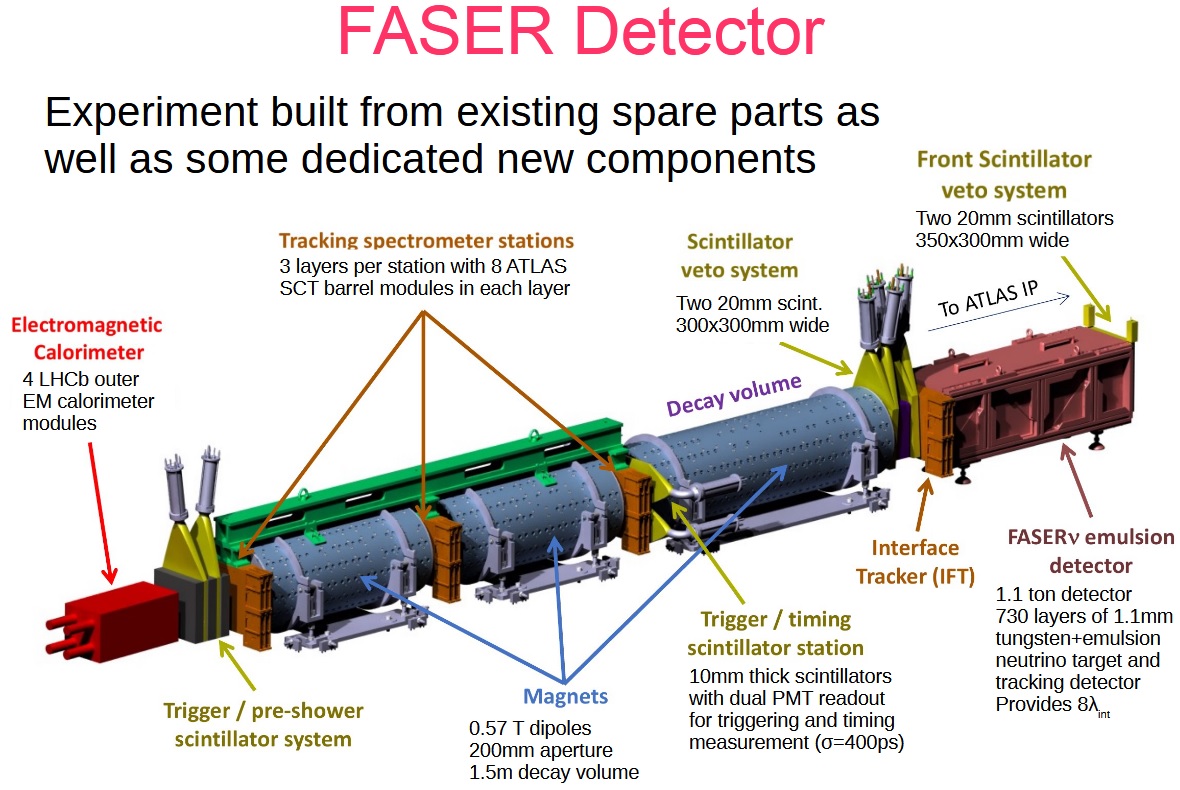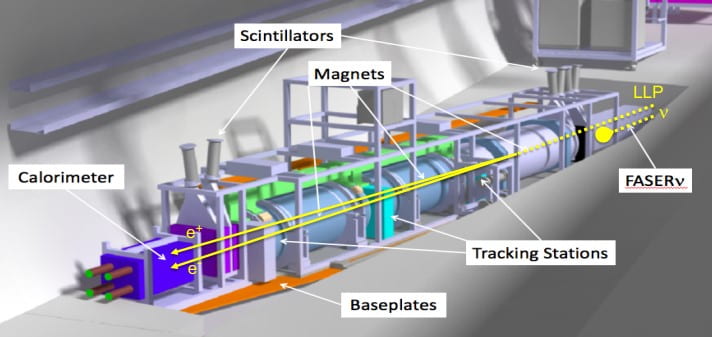Taking a closer look at LHC
(Taken from FASER-CERN)
FASER (Forward Search Experiment), is designed to search for light and extremely weakly interacting particles. The existence of such new particles is predicted by many models beyond the Standard Model that attempt to solve some of the biggest puzzles in physics, such as the nature of dark matter, the origin of neutrino masses, and the imbalance between matter and antimatter in the present-day universe.
The four main LHC detectors, ALICE, ATLAS, CMS and LHCb, are not suited to detect signals from light and weakly interacting particles produced parallel to the proton beamline, because they have holes along the beamline to let the proton beams through. Located along the beam trajectory, 480 metres downstream of the ATLAS detector, FASER is ideally positioned to detect the particles into which such light and weakly interacting particles will decay.
FASER also comprise a subdetector called FASERν, which is specifically designed to detect neutrinos. No neutrino produced at a particle collider has ever been detected, despite colliders producing them in huge numbers and at high energies. As a result, neutrino interactions at these high energies have not yet been studied in detail. The FASERν">ν detector is a 25\cm×25\cm×1.35\m">25\cm×25\cm×1.35\m emulsion detector, consisting of 1000 layers of emulsion films interleaved with 1-mm-thick tungsten plates, with a total tungsten target mass of 1.2 tons. It is located at the front of the FASER main detector in a narrow trench being excavated specifically to house it.
First Measurement of the νe and νμ Interaction Cross Sections at the LHC with FASER's Emulsion Detector.
At the annual Rencontres de Moriond conference (2024), the FASER collaboration presented a measurement of the interaction strength, or "cross section," of electron neutrinos (νe) and muon neutrinos (νμ).
This is the first time such a measurement has been made at a particle collider. Measurements of this kind can provide important insights across different aspects of physics, from understanding the production of "forward" particles in the LHC collisions and improving our understanding of the structure of the proton to interpreting measurements of high-energy neutrinos from astrophysical sources performed by neutrino-telescope experiments.

Image taken from Brian Petersen – The FASER Collaboration

Image: Institute for Fundamental Science
(University of Oregon)
https://ifs.uoregon.edu/faser-experiment-at-cern/
|
AUTHORS Xabier Cid Vidal, PhD in experimental Particle Physics for Santiago University (USC). Research Fellow in experimental Particle Physics at CERN from January 2013 to Decembre 2015. He was until 2022 linked to the Department of Particle Physics of the USC as a "Juan de La Cierva", "Ramon y Cajal" fellow (Spanish Postdoctoral Senior Grants), and Associate Professor. Since 2023 is Senior Lecturer in that Department.(ORCID). Ramon Cid Manzano, until his retirement in 2020 was secondary school Physics Teacher at IES de SAR (Santiago - Spain), and part-time Lecturer (Profesor Asociado) in Faculty of Education at the University of Santiago (Spain). He has a Degree in Physics and a Degree in Chemistry, and he is PhD for Santiago University (USC) (ORCID). |
CERN CERN Experimental Physics Department CERN and the Environment |
LHC |
IMPORTANT NOTICE
For the bibliography used when writing this Section please go to the References Section
© Xabier Cid Vidal & Ramon Cid - rcid@lhc-closer.es | SANTIAGO (SPAIN) |



